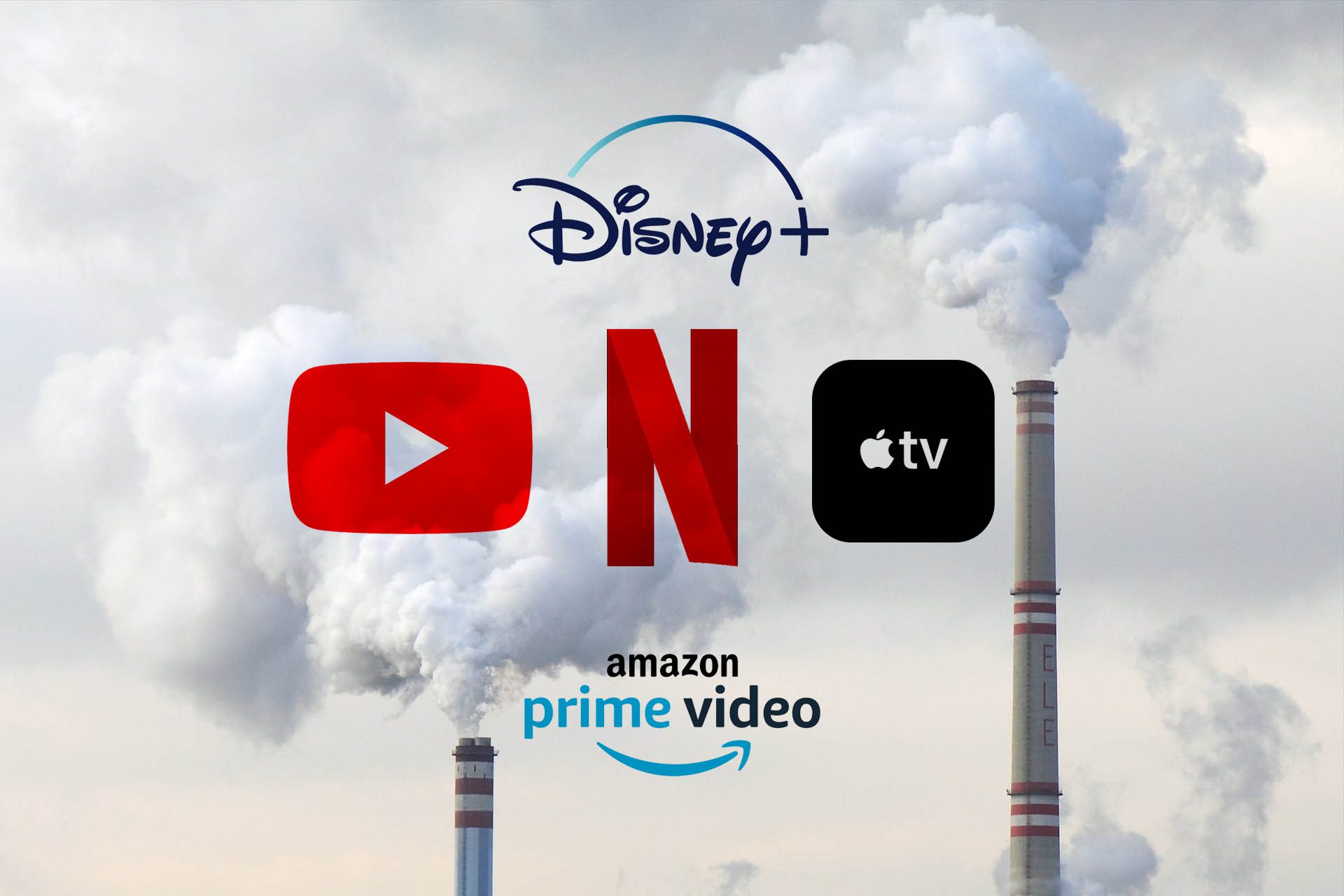Streaming and environmentalism: a cloud not as light as was thought

Article author :
From YouTube to Netflix, video streaming has revolutionised our consumption practices. The supply is infinite, available instantly; data has been dematerialised, travelling from the cloud to our screens as if by magic. Unlimited + virtual: the perfect combination to sow the seeds in our minds of the idea that an online video has no value, and its consumption has little impact. But is streaming really as green as all that?
According to a recent study carried out by the French Agency for Energy Transition (ADEME) and the French Electronic Communications Regulatory Authority (ARCEP), video streaming will soon harness 80% of global web traffic. But what is the environmental impact of such traffic? If a lot of research has been carried out on the subject, the calculation methods differ greatly from one document to the next, producing very disparate data. The various figures that have been claimed are nevertheless enough to make one’s head spin.
According to a study by the University of Bristol, YouTube in one year produced 11 million tons of CO2, in other words, more than the annual emissions of Luxembourg. In 2019, the French think tank The Shift Project published its report, “Climate: the unsustainable use of online video”, claiming that the online video industry on its own generated 306 million tons of CO2 in one year, close to the equivalent of the emissions produced by France. Whilst certain figures within the report have been disputed, it can be suggested, in light of the studies available, that one hour of consumption on Netflix emits, depending on the methods used, between 36 and 400 g of CO2 emissions, in other words, the equivalent of a car journey of 200 m to 2 km. That reaches vertiginous levels on a worldwide scale: in 2021, the ten most popular series on Netflix in one month totalled over 6 billion viewing hours. The University of Bristol has estimated that this consumption is the equivalent of 1.8 billion kilometres travelled by car. The journey required to travel from the Earth to … Saturn.
The emissions linked to digital technology are currently said to comprise from 3 to 4% of worldwide CO2 emissions, and are predicted to rise to around 6% in 2025. By way of comparison, the proportion of car industry emissions is estimated to be 9%.

Data centres: from coal to green energies
Yet the vocabulary was reassuring: our series are virtual, stored in the cloud, this small, pure, light and transparent cloud. However little the dreamers may like it, data needs a physical support to exist and circulate. A support which consumes, and which pollutes, especially bearing in mind that a number of data centres, these immense data factories dispersed all around the world, are still coal powered. According to the ADEME, the emissions from data centres amount to 16% of the CO2 emissions produced by digital technology. The International Energy Agency has estimated them to be, combined with those produced by the data transmission networks, in the order of 300 million tons of CO2 per year.
There is nevertheless some positive news: the development of hyperscale centres, immense clusters of data centres which, in pooling their equipment and using the most recent innovations to date, which are less polluting, drastically reduce their emissions. A development which raises other concerns: whilst they are proportionally greener, the fact remains that, given their size, they consume enormous amounts, at times requisitioning significant proportions of the locally available energy. In Ireland, for example, these data centres consumed 14% of the country’s electricity in 2021.

One small screen for man, one giant disaster for mankind
If estimations as to the impact of the storing and transmission of data vary depending on the study, scientists concur on one thing: the majority of the pollution stems from the supports on which we consume our videos. It is estimated that 70% of digital technology’s carbon footprint is due solely to the manufacturing of terminals.
Let us take the example of a smartphone. A smartphone consists of some forty or so different materials. Amongst them are what are known as rare-earth elements, which, contrary to what their name suggests, are found everywhere, but in very low densities. Enormous quantities of materials therefore need to be extracted in order to gain access to them (it is estimated that a smartphone requires between 500 and 1,000 times its weight in raw materials to be produced), and to separate these rare-earth elements from the metals they are combined with in the earth’s crust, such as uranium and thorium, minerals which are … radioactive. The extraction and treatment processes are toxic and polluting, and entail a significant production of waste, devastating for the environment and the inhabitants of the regions concerned. According to a report issued by the Baotou Environmental Protection Bureau (Mongolia), where the largest Chinese rare-earth element production site is located (Bayan Obo, supplying around half of the world’s rare-earth elements and considered to be one of the most polluted areas on the planet), soil samples taken near landfill sites had levels of thorium, a radioactive element, which were 36 times higher than normal. The waste especially contaminates the Yellow River, which provides 155 million people with water. Wonderful. It’s hardly surprising that nearly every country in the world has made sure to export these processes far from their own borders (China currently has 90% of the world’s production of rare-earth elements, incidentally turning it into an authentic economic weapon).
Apart from manufacturing, the lifespan of our devices is obviously a concern. The Parisian average for keeping a smartphone is 18 months. According to the researcher Gauthier Roussilhe, interviewed by Arte at the end of 2022, it should be 10 years. Can you imagine watching a series on the phone you had … in 2013? That is where the problem lies: they get replaced, often not because they are broken, but to keep up with the breakneck pace of technological developments and the ever-increasing consumption they allow. On every major innovation (the arrival of 3, 4 and soon 5G), it is the whole stock of mobile phones which becomes obsolete and needs replacing.
Bearing in mind that at this point in time no recycling exists, or scarcely any, this race for data on ever more high-performance devices gives somewhat of a headache.

So then, what do we do?
How can we adapt our behaviour to reduce the impact of our digital technology use, without actually throwing out our telephones and televisions and disappearing for ever into a vortex of eco-anxiety?
For a start, by being aware of our impact. On this subject, the ADEME has placed online a digital technology use impact calculator. Always useful to get some idea of our practices.
Then, most importantly, by trying to keep our devices for longer. By looking after them, by having them repaired. By investing in smaller televisions as well, or by choosing to use a projector instead, the manufacturing of which is less greedy for raw materials. In short, broadly speaking, by trying to resist the exhortations of always bigger, new and high-performance.
Concerning the use of streaming, it is preferable to use Wi-Fi rather than mobile phone networks, which are two to three times more energy-intensive. In the same vein, we will try to download our videos in advance, during off-peak periods, rather than consuming them live whilst travelling. We will also make sure that, when possible, we deactivate the video on musical content. It is also recommended to deactivate the auto-play on videos, and to adapt the image resolution to the device on which we are viewing them.
It is obvious that the change must not be driven solely by eco-citizens. The studies also offer recommendations with the public authorities in mind, calling on them to provide more regulation of both the manufacturers (an increase in the guarantee, oversight for upgrades, etc.) and of the telecom operators (the regulation of data bundle offers, in particular). Finally, it is worth noting that several VOD platforms seem to be committing themselves to eco-responsible processes. Whether it be due to marketing necessity or to a genuine commitment, it is a good thing that these outcomes exist!
So, no, all is not lost! To take things further, we recommend:
This series of documentaries (Arte) (via streaming, yes, human beings are contradictory); this very technical but very comprehensive article by Gauthier Roussilhe, a researcher who specialises in the environmental issues of digital technology, and the resources he suggests on his site; the podcast How to train your smartphone (Arte radio); the ADEME and ARCEP study; the one published by Carbon Trust; the Shift Project report, the criticisms of it and the responses to those criticisms; or this study by Green IT on the environmental footprint of the global digital sector, as well as the various resources which the site makes available to encourage responsible use of digital technology.
A story, projects or an idea to share?
Suggest your content on kingkong.




